
List of domesticated Scottish breeds
Encyclopedia
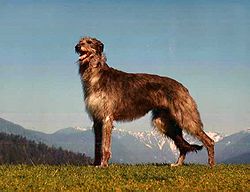
Ethology
Ethology is the scientific study of animal behavior, and a sub-topic of zoology....
, life cycle
Biological life cycle
A life cycle is a period involving all different generations of a species succeeding each other through means of reproduction, whether through asexual reproduction or sexual reproduction...
, or physiology
Physiology
Physiology is the science of the function of living systems. This includes how organisms, organ systems, organs, cells, and bio-molecules carry out the chemical or physical functions that exist in a living system. The highest honor awarded in physiology is the Nobel Prize in Physiology or...
systemically altered as a result of being under human control for many generations.
Scotland has produced some of the longest established breeds of domesticated animals still in existence. The Soay Sheep
Soay sheep
The Soay sheep is a primitive breed of domestic sheep descended from a population of feral sheep on the island of Soay in the St. Kilda Archipelago, about from the Western Isles of Scotland...
has prehistoric
Prehistory
Prehistory is the span of time before recorded history. Prehistory can refer to the period of human existence before the availability of those written records with which recorded history begins. More broadly, it refers to all the time preceding human existence and the invention of writing...
origins, and the Galloway
Galloway cattle
The Galloway is one of the world's longest established breeds of beef cattle, named after the Galloway region of Scotland, where it originated. It is now found in many parts of the world....
breed of beef cattle
Beef cattle
Beef cattle are cattle raised for meat production . The meat of cattle is known as beef. When raised in a feedlot cattle are known as feeder cattle. Many such feeder cattle are born in cow-calf operations specifically designed to produce beef calves...
dates back several hundred years. New breeds have also been developed more recently in Scotland, such as the Scottish Fold
Scottish Fold
The Scottish Fold is a breed of cat with a natural dominant-gene mutation that makes its ear cartilage contain a fold, causing the ears to bend forward and down towards the front of their head, which gives the cat what is often described as an "owl-like" appearanceOriginally called lop-eared or...
cat, which dates from 1961.
The North Ronaldsay Sheep
North Ronaldsay sheep
The North Ronaldsay is a breed of sheep living on North Ronaldsay, the northernmost of the Orkney Islands, Scotland. They are one survivor of a type of sheep formerly found across the islands of Orkney and Shetland , belonging to the Northern European short-tailed sheep group of breeds.They are...
is a most unusual breed, subsisting largely on a diet of seaweed
Seaweed
Seaweed is a loose, colloquial term encompassing macroscopic, multicellular, benthic marine algae. The term includes some members of the red, brown and green algae...
, and the Boreray
Boreray (sheep)
The Boreray is a breed of sheep originating on the St Kilda archipelago off the west coast of Scotland and surviving as a feral animal on one of the islands, Boreray. It is primarily a meat breed...
is the UK's rarest sheep, having been listed as "Category 1: Critical" by the Rare Breeds Survival Trust
Rare Breeds Survival Trust
The Rare Breeds Survival Trust is a conservation charity, whose purpose is to secure the continued existence and viability of the United Kingdom’s native farm animal genetic resources...
. Some breeds, such as the Shetland Pony
Shetland pony
The Shetland pony is a breed of pony originating in the Shetland Isles. Shetlands range in size from a minimum height of approximately 28 inches to an official maximum height of 42 inches at the withers. Shetland ponies have heavy coats, short legs and are considered quite intelligent...
and the Border Collie
Border Collie
The Border Collie is a herding dog breed developed in the Anglo-Scottish border region for herding livestock, especially sheep. It is the most widespread of the collie breeds....
are well known throughout much of the Western world
Western world
The Western world, also known as the West and the Occident , is a term referring to the countries of Western Europe , the countries of the Americas, as well all countries of Northern and Central Europe, Australia and New Zealand...
, whilst others such as the Scots Dumpy
Scots Dumpy
The Scots Dumpy is a breed of chicken from Scotland. The moniker dumpy, meaning short and stout, refers the breed's thick-set appearance and extremely short legs. Through history they have been known under a host of names such as: Bakies, Stumpies, Dadlies, Hoodies, or Creepies...
chicken are little-known, even at home. Several breeds of dog have Scottish origins, including no fewer than five from the island of Skye
Skye
Skye or the Isle of Skye is the largest and most northerly island in the Inner Hebrides of Scotland. The island's peninsulas radiate out from a mountainous centre dominated by the Cuillin hills...
. Indeed the relative isolation of many of Scotland's numerous islands has led to a preponderance of breeds from these places being represented. Various breeds are now extinct, including the Grice
Grice
Grice may refer to:*Grice, an extinct breed of pig from Scotland and Ireland-Grice:*Allan Grice, is an Australian former racing driver.*Frank Grice, was an English professional footballer....
, an archaic and somewhat aggressive pig.
Extant breeds
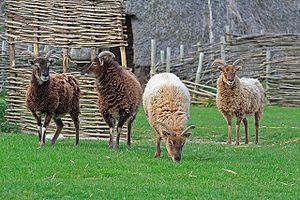
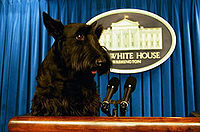
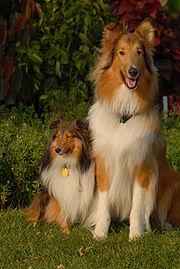

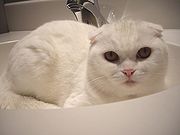
| Breed | Species | Date of Origin | Location of Origin | Status |
|---|---|---|---|---|
| Scottish Fold Scottish Fold The Scottish Fold is a breed of cat with a natural dominant-gene mutation that makes its ear cartilage contain a fold, causing the ears to bend forward and down towards the front of their head, which gives the cat what is often described as an "owl-like" appearanceOriginally called lop-eared or... |
Cat Cat The cat , also known as the domestic cat or housecat to distinguish it from other felids and felines, is a small, usually furry, domesticated, carnivorous mammal that is valued by humans for its companionship and for its ability to hunt vermin and household pests... |
1961 | Coupar Angus Coupar Angus Coupar Angus is a town in Perth and Kinross, Scotland, situated eight kilometres south of Blairgowrie.The name Coupar Angus serves to differentiate the town from Cupar, Fife... |
Rare |
| Aberdeen Angus Angus cattle Angus cattle are a breed of cattle much used in beef production. They were developed from cattle native to the counties of Aberdeenshire and Angus in Scotland, and are known as Aberdeen Angus in most parts of the world.... |
Cattle Cattle Cattle are the most common type of large domesticated ungulates. They are a prominent modern member of the subfamily Bovinae, are the most widespread species of the genus Bos, and are most commonly classified collectively as Bos primigenius... |
18th century | Angus Angus Angus is one of the 32 local government council areas of Scotland, a registration county and a lieutenancy area. The council area borders Aberdeenshire, Perth and Kinross and Dundee City... |
Common |
| Ayrshire Cattle Ayrshire cattle The Ayrshire cattle is a breed of dairy cattle originated from Ayrshire in Scotland. The average mature Ayrshire cow weighs 1,000-1,300 pounds . Ayrshires have red markings. The red can be an orange to a dark brown, with or without coloured legs. They are known for low somatic cell counts,... |
Cattle | prior to 1800 | Ayrshire Ayrshire Ayrshire is a registration county, and former administrative county in south-west Scotland, United Kingdom, located on the shores of the Firth of Clyde. Its principal towns include Ayr, Kilmarnock and Irvine. The town of Troon on the coast has hosted the British Open Golf Championship twice in the... |
Common |
| Belted Galloway Belted Galloway The Belted Galloway is a rare beef breed of cattle originating from Galloway in South West Scotland, adapted to living on the poor upland pastures and windswept moorlands of the region... |
Cattle | 17–18th century | Galloway Galloway Galloway is an area in southwestern Scotland. It usually refers to the former counties of Wigtownshire and Kirkcudbrightshire... |
Rare |
| Galloway Galloway cattle The Galloway is one of the world's longest established breeds of beef cattle, named after the Galloway region of Scotland, where it originated. It is now found in many parts of the world.... |
Cattle | 700–1100 | Galloway | Established worldwide |
| Highland Cattle Highland cattle Highland cattle or kyloe are a Scottish breed of beef cattle with long horns and long wavy coats which are coloured black, brindled, red, yellow or dun.... |
Cattle | Pre 19th century | West Highlands Scottish Highlands The Highlands is an historic region of Scotland. The area is sometimes referred to as the "Scottish Highlands". It was culturally distinguishable from the Lowlands from the later Middle Ages into the modern period, when Lowland Scots replaced Scottish Gaelic throughout most of the Lowlands... |
Established worldwide |
| Luing Cattle Luing cattle Luing cattle are a beef breed developed on the island of Luing in the Inner Hebrides of Scotland by the Cadzow brothers; Ralph, Denis and Shane, after 1947. It was formed by breeding first cross Beef Shorthorn/Highland heifers to a Beef Shorthorn bull. The breed of red-brown cattle are moderately... |
Cattle | Post 1947 | Luing Luing Luing is one of the Slate Islands, Firth of Lorn, in the west of Argyll in Scotland, about 16 miles south of Oban. It has a population of around 200 people, mostly living in Cullipool, Toberonochy , and Blackmillbay... |
"Firmly established" |
| Shetland Cattle Shetland cattle Shetland cattle are a small, hardy cattle breed from the Shetland Isles off the north coast of Scotland. Shetland cattle possess their characteristic genetic qualities of thriftiness, productivity and hardiness, through adaptation and survival in one of the United Kingdom's most rigorous environments... |
Cattle | 700–1100 | Shetland | At risk |
| Scots Dumpy Scots Dumpy The Scots Dumpy is a breed of chicken from Scotland. The moniker dumpy, meaning short and stout, refers the breed's thick-set appearance and extremely short legs. Through history they have been known under a host of names such as: Bakies, Stumpies, Dadlies, Hoodies, or Creepies... |
Chicken Chicken The chicken is a domesticated fowl, a subspecies of the Red Junglefowl. As one of the most common and widespread domestic animals, and with a population of more than 24 billion in 2003, there are more chickens in the world than any other species of bird... |
11th century | Highlands Scottish Highlands The Highlands is an historic region of Scotland. The area is sometimes referred to as the "Scottish Highlands". It was culturally distinguishable from the Lowlands from the later Middle Ages into the modern period, when Lowland Scots replaced Scottish Gaelic throughout most of the Lowlands... |
Rare |
| Scots Grey Scots Grey The Scots Grey, originally titled the Scotch Grey, is a breed of chicken originating in Scotland. It is so named because of its striped plumage, which is called either Barred or Cuckoo by poultry enthusiasts. Though superficially similar to breeds such as the Cuckoo Marans and Barred Plymouth Rock,... |
Chicken | 16th century | Lanarkshire Lanarkshire Lanarkshire or the County of Lanark ) is a Lieutenancy area, registration county and former local government county in the central Lowlands of Scotland... |
Rare |
| Bearded Collie Bearded Collie The Bearded Collie, or Beardie, is a herding breed of dog once used primarily by Scottish shepherds, but now mostly a popular family companion.... |
Dog Dog The domestic dog is a domesticated form of the gray wolf, a member of the Canidae family of the order Carnivora. The term is used for both feral and pet varieties. The dog may have been the first animal to be domesticated, and has been the most widely kept working, hunting, and companion animal in... |
16th century? | Scottish Borders Scottish Borders The Scottish Borders is one of 32 local government council areas of Scotland. It is bordered by Dumfries and Galloway in the west, South Lanarkshire and West Lothian in the north west, City of Edinburgh, East Lothian, Midlothian to the north; and the non-metropolitan counties of Northumberland... ? |
Common |
| Border Collie Border Collie The Border Collie is a herding dog breed developed in the Anglo-Scottish border region for herding livestock, especially sheep. It is the most widespread of the collie breeds.... |
Dog | pre 19th century | Possibly Scottish Borders | Common |
| Border Terrier Border Terrier The Border Terrier is a small, rough-coated breed of dog of the terrier group. Originally bred as fox and vermin hunters, Border Terriers share ancestry with Dandie Dinmont Terriers and Bedlington Terriers.... |
Dog | c. 1790 | Scottish Borders | Common |
| Cairn Terrier Cairn Terrier The Cairn Terrier is the oldest of the terrier breeds, originating in the Scottish Highlands and recognized as one of Scotland's earliest working dogs... |
Dog | 16th century–19th century. | Skye Skye Skye or the Isle of Skye is the largest and most northerly island in the Inner Hebrides of Scotland. The island's peninsulas radiate out from a mountainous centre dominated by the Cuillin hills... |
Common |
| Dandie Dinmont Dandie Dinmont Terrier A Dandie Dinmont Terrier is a small Scottish breed of dog in the terrier family. The breed has a very long body, short legs, and a distinctive "top-knot" of hair on the head. A character in Sir Walter Scott's novel Guy Mannering has lent the name to the breed, with "Dandie Dinmont" thought to be... |
Dog | mid 18th century or before | Skye and Scottish Borders | Rare |
| Golden Retriever Golden Retriever The Golden Retriever is a medium-sized breed of dog. They were historically developed as gundogs to retrieve shot waterfowl such as ducks and upland game birds during hunting and shooting parties. As such, they were bred to have a soft mouth to retrieve game undamaged and have an instinctive love... |
Dog | 19th century | Glen Affric Glen Affric right|300px|thumb|Glen AffricGlen Affric is a glen south-west of the village of Cannich in the Highland region of Scotland, some to the west of Loch Ness. The River Affric runs along its length, passing through Loch Affric and Loch Beinn a' Mheadhoin .It used to be part of the lands of the Clan... |
Common |
| Gordon Setter Gordon Setter A Gordon Setter is a large breed of dog, a member of the setter family that also includes both the better-known Irish Setter and the English Setter. Setter breeds are classified as members of either the Sporting or Gundog Group depending on the national kennel club or council. The original purpose... |
Dog | 1820s | Moray Moray Moray is one of the 32 council areas of Scotland. It lies in the north-east of the country, with coastline on the Moray Firth, and borders the council areas of Aberdeenshire and Highland.- History :... |
Bred in UK and US |
| Rough Collie Rough Collie The Rough Collie is a long coated breed of medium to large size dog that in its original form was a type of collie used and bred for herding in Scotland. Originating in the 1800's, it is now well known through the works of author Albert Payson Terhune, and through the Lassie novel, movies, and... and Smooth Collie Smooth Collie The Smooth Collie is a breed of dog developed originally for herding. It is a short-coated version of the Rough Collie of Lassie fame. Some breed organisations consider the smooth-coat and rough-coat dogs to be variations of the same breed.-History:... |
Dog | 19th century | England, partly using working Collies from Scotland. | Common |
| Scottish Terrier Scottish Terrier The Scottish Terrier , popularly called the Scottie, is a breed of dog. Initially one of the highland breeds of Terrier that were grouped under the name of Skye Terrier, it is one of five breeds of terrier that originated in Scotland, the other four being the modern Skye, Cairn, Dandie Dinmont, and... or Scottie |
Dog | 16th century–19th century | Skye | Common |
| Scottish Deerhound Scottish Deerhound The Scottish Deerhound, or simply the Deerhound, is a breed of hound , once bred to hunt the Red Deer by coursing.- Appearance :The Scottish Deerhound resembles a rough-coated Greyhound. It is however, larger in size and bone... |
Dog | 16th century or older | Probably the Highlands | Bred in UK and US |
| Shetland Sheepdog Shetland Sheepdog The Shetland Sheepdog, often known as the Sheltie, is a breed of herding dog.They are small to medium dogs, and come in a variety of colors, such as sable/white, tri-color, and blue merle. They are vocal, excitable, energetic dogs who are always willing to please and work hard... or Sheltie |
Dog | 1700 | England, partly using shepherd dogs from Shetland of now extinct type. | |
| Skye Terrier Skye Terrier The Skye Terrier is a breed of dog that is a long, low, hardy terrier.-Coat:The Skye is double coated, with a short, soft undercoat and a hard, straight topcoat. The ideal coat length is 5 inches , with no extra credit for a longer coat. The shorter hair of the head veils the forehead and... |
Dog | pre 1588 | Skye | Vulnerable Native Breed Vulnerable Native Breeds thumb|right|There were only 37 Skye Terrier puppies registered with the Kennel Club in 2010Vulnerable Native Breeds are a group of dog breeds originating in the United Kingdom and Ireland, and identified by The Kennel Club as having annual registration numbers of 300 puppies or fewer... |
| West Highland White Terrier West Highland White Terrier The West Highland White Terrier, commonly known as the Westie, is a Scottish breed of dog with a distinctive white coat. The modern breed is descended from a number of breeding programes of white terriers in Scotland prior to the 20th century... or Westie |
Dog | mid 19th century | Skye & Argyll Argyll Argyll , archaically Argyle , is a region of western Scotland corresponding with most of the part of ancient Dál Riata that was located on the island of Great Britain, and in a historical context can be used to mean the entire western coast between the Mull of Kintyre and Cape Wrath... |
Common |
| Shetland Goose Shetland Goose The Shetland Goose is a breed of domestic geese originating in the Shetland Islands in Scotland. Like the other livestock breeds native to the islands, the Shetland Goose is small in stature, generally weighing between 12 and 14 pounds... |
Goose Goose The word goose is the English name for a group of waterfowl, belonging to the family Anatidae. This family also includes swans, most of which are larger than true geese, and ducks, which are smaller.... |
? | Shetland | UK and US - Critical |
| Clydesdale | Horse Horse The horse is one of two extant subspecies of Equus ferus, or the wild horse. It is a single-hooved mammal belonging to the taxonomic family Equidae. The horse has evolved over the past 45 to 55 million years from a small multi-toed creature into the large, single-toed animal of today... |
mid 18th century | Clydesdale Clydesdale Clydesdale was formerly one of nineteen local government districts in the Strathclyde region of Scotland.The district was formed by the Local Government Act 1973 from part of the former county of Lanarkshire: namely the burghs of Biggar and Lanark and the First, Second and Third Districts... |
At Risk |
| Eriskay Pony Eriskay pony The Eriskay Pony is a breed of pony from Scotland. It is generally grey in colour, and has a dense, waterproof coat that protects it in harsh weather. The breed developed in ancient times in the Hebrides islands in Scotland, and a small population remained pure and protected from crossbreeding by... |
Horse | Hebrides Hebrides The Hebrides comprise a widespread and diverse archipelago off the west coast of Scotland. There are two main groups: the Inner and Outer Hebrides. These islands have a long history of occupation dating back to the Mesolithic and the culture of the residents has been affected by the successive... |
Critical | |
| Highland Pony Highland Pony The Highland Pony is a native Scottish pony, and is one of the largest of the mountain and moorland pony breeds of the British Isles. Its pedigree dates back to the 1880s... |
Horse | 16th century | Highlands and Islands Highlands and Islands The Highlands and Islands of Scotland are broadly the Scottish Highlands plus Orkney, Shetland and the Hebrides.The Highlands and Islands are sometimes defined as the area to which the Crofters' Act of 1886 applied... |
At Risk |
| Shetland Pony Shetland pony The Shetland pony is a breed of pony originating in the Shetland Isles. Shetlands range in size from a minimum height of approximately 28 inches to an official maximum height of 42 inches at the withers. Shetland ponies have heavy coats, short legs and are considered quite intelligent... |
Horse | "For over 2000 years and probably much longer". | Shetland | Common |
| Boreray Boreray (sheep) The Boreray is a breed of sheep originating on the St Kilda archipelago off the west coast of Scotland and surviving as a feral animal on one of the islands, Boreray. It is primarily a meat breed... or Hebridean Blackface |
Sheep Domestic sheep Sheep are quadrupedal, ruminant mammals typically kept as livestock. Like all ruminants, sheep are members of the order Artiodactyla, the even-toed ungulates. Although the name "sheep" applies to many species in the genus Ovis, in everyday usage it almost always refers to Ovis aries... |
1930s | St Kilda, Scotland St Kilda, Scotland St Kilda is an isolated archipelago west-northwest of North Uist in the North Atlantic Ocean. It contains the westernmost islands of the Outer Hebrides of Scotland. The largest island is Hirta, whose sea cliffs are the highest in the United Kingdom and three other islands , were also used for... |
Critical |
| Castlemilk Moorit | Sheep | 1900s | Dumfriesshire Dumfriesshire Dumfriesshire or the County of Dumfries is a registration county of Scotland. The lieutenancy area of Dumfries has similar boundaries.Until 1975 it was a county. Its county town was Dumfries... , from more ancient Scottish and other breeds including Soay and Shetland. |
Critical |
| Cheviot Cheviot sheep The Cheviot is a breed of white faced sheep which gets its name from a range of hills in north Northumberland and the Scottish Borders. It is still common in this area of the United Kingdom, but also in north west Scotland, Wales and the south west of England as well as more rarely in Australia,... |
Sheep | 14th century or earlier | Scottish Borders Scottish Borders The Scottish Borders is one of 32 local government council areas of Scotland. It is bordered by Dumfries and Galloway in the west, South Lanarkshire and West Lothian in the north west, City of Edinburgh, East Lothian, Midlothian to the north; and the non-metropolitan counties of Northumberland... |
Common |
| Hebridean Sheep Hebridean (sheep) The Hebridean is a breed of small black sheep from Scotland, similar to other members of the Northern European short-tailed sheep group, having a short, triangular tail. They often have two pairs of horns... |
Sheep | 19th Century (Iron Age) | Cumbria, probably from sheep from the Hebrides Hebrides The Hebrides comprise a widespread and diverse archipelago off the west coast of Scotland. There are two main groups: the Inner and Outer Hebrides. These islands have a long history of occupation dating back to the Mesolithic and the culture of the residents has been affected by the successive... |
Rare |
| North Country Cheviot North Country Cheviot North Country Cheviot sheep are a type of Cheviot. They are bred predominantly in Scotland, but are also bred in other parts of the United Kingdom, including Northern Ireland. They are raised primarily for meat.-Origin:... |
Sheep | 18th century | Cheviot Hills Cheviot Hills The Cheviot Hills is a range of rolling hills straddling the England–Scotland border between Northumberland and the Scottish Borders.There is a broad split between the northern and the southern Cheviots... , Caithness Caithness Caithness is a registration county, lieutenancy area and historic local government area of Scotland. The name was used also for the earldom of Caithness and the Caithness constituency of the Parliament of the United Kingdom . Boundaries are not identical in all contexts, but the Caithness area is... , Sutherland Sutherland Sutherland is a registration county, lieutenancy area and historic administrative county of Scotland. It is now within the Highland local government area. In Gaelic the area is referred to according to its traditional areas: Dùthaich 'IcAoidh , Asainte , and Cataibh... |
UK and North America |
| North Ronaldsay Sheep North Ronaldsay sheep The North Ronaldsay is a breed of sheep living on North Ronaldsay, the northernmost of the Orkney Islands, Scotland. They are one survivor of a type of sheep formerly found across the islands of Orkney and Shetland , belonging to the Northern European short-tailed sheep group of breeds.They are... |
Sheep | Iron Age | North Ronaldsay North Ronaldsay North Ronaldsay is the northernmost of the Orkney Islands, Scotland and with an area of is the fourteenth largest.-Geography:North Ronaldsay lies around north of its nearest neighbour, Sanday at . The island is around long along its length and is defined by two large sandy bays; Linklet Bay on... |
Rare |
| Scottish Blackface | Sheep | 16th century? | Scottish Borders | Common |
| Shetland Sheep Shetland (sheep) The Shetland sheep is a small, fine-woolled breed of sheep originating in the Shetland Isles, but now also kept in many other parts of the world. It is one of the Northern European short-tailed sheep group, and is closely related to the extinct Scottish Dunface. Shetlands are classed as a... |
Sheep | Iron Age | Shetland | UK and North America |
| Soay Sheep Soay sheep The Soay sheep is a primitive breed of domestic sheep descended from a population of feral sheep on the island of Soay in the St. Kilda Archipelago, about from the Western Isles of Scotland... |
Sheep | Neolithic or Bronze Age | Soay, St Kilda Soay, St Kilda Soay is an uninhabited islet in the St Kilda archipelago, Scotland. The island is part of the St Kilda World Heritage Site and home to a primitive breed of sheep... |
Rare |
Extinct breeds
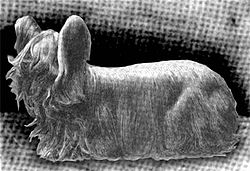
Yorkshire Terrier
The Yorkshire Terrier is a small dog breed of terrier type, developed in the 19th century in the county of Yorkshire, England to catch rats in clothing mills. The defining features of the breed are its size, to , and its silky blue and tan coat...
and the Scottish Tan Face to the Boreray sheep. Although Galloway Ponies were praised by Gervaise Markham in the 17th century for their "fine shape, easie pace, pure metall and infinit toughness", true to form Samuel Johnson
Samuel Johnson
Samuel Johnson , often referred to as Dr. Johnson, was an English author who made lasting contributions to English literature as a poet, essayist, moralist, literary critic, biographer, editor and lexicographer...
described them as "common hackneys". It shares its origins with the still extant Fell Pony
Fell pony
The Fell Pony is a versatile, working breed of mountain and moorland pony originating in the north of England in Cumberland and Westmorland and Northumberland. It was originally bred on the fell farms of northwest England, and is used as a riding and driving pony...
. A model of the Grice, whose habit of attacking lambs cannot have aided its survival, was recreated by a taxidermist in 2006.
| Breed | Species | Date of Origin | Location of Origin | Date of extinction |
|---|---|---|---|---|
| Paisley Terrier Paisley Terrier The Paisley Terrier was a breed of terrier type dog from Great Britain. The breed is now extinct. The Paisley Terrier was bred primarily as a pet and showdog version of the Skye Terrier, and was the progenitor of today's Yorkshire Terrier... or Clydesdale Terrier |
Dog | 19th century | Paisley Paisley Paisley is the largest town in the historic county of Renfrewshire in the west central Lowlands of Scotland and serves as the administrative centre for the Renfrewshire council area... , Clyde Valley |
20th century |
| Galloway Pony Galloway pony The Galloway pony is an extinct horse breed, once native to Scotland and northern England. It was said to have "good looks, a wide, deep chest and a tendency to pace rather than trot."... |
Horse | 16th century or earlier | Galloway | post 1901 |
| Grice Grice Grice may refer to:*Grice, an extinct breed of pig from Scotland and Ireland-Grice:*Allan Grice, is an Australian former racing driver.*Frank Grice, was an English professional footballer.... |
Pig Domestic pig The domestic pig is a domesticated animal that traces its ancestry to the wild boar, and is considered a subspecies of the wild boar or a distinct species in its own right. It is likely the wild boar was domesticated as early as 13,000 BC in the Tigris River basin... |
Unknown | Highlands and Islands (also Ireland) | c. 1930 |
| Scottish Dunface Scottish Dunface The Scottish Dunface, Old Scottish Short-wool, Scottish Whiteface or Scottish Tanface was a type of sheep from Scotland. It was one of the Northern European short-tailed sheep group, and it was probably similar to the sheep kept throughout the British Isles in the Iron Age... or Old Scottish Shortwool |
Sheep | Iron Age Iron Age The Iron Age is the archaeological period generally occurring after the Bronze Age, marked by the prevalent use of iron. The early period of the age is characterized by the widespread use of iron or steel. The adoption of such material coincided with other changes in society, including differing... |
Highlands and Islands (previously British Isles) | late 19th century (Survives as Shetland, Boreray, North Ronaldsay, Hebridean.) |
See also
- Fauna of ScotlandFauna of ScotlandThe fauna of Scotland is generally typical of the northwest European part of the Palearctic ecozone, although several of the country's larger mammals were hunted to extinction in historic times and human activity has also led to various species of wildlife being introduced...
- Shetland animal breedsShetland animal breedsShetland has long had its own distinct animal breeds because of the area being made up of remote islands. Below is a list of Shetland's domesticated animals.- Shetland Pony :The Shetland pony is a very small, robust breed of pony...
- Greyfriars BobbyGreyfriars BobbyGreyfriars Bobby was a Skye Terrier who became known in 19th-century Edinburgh for spending 14 years guarding the grave of his owner, John Gray , until he died himself on 14 January 1872...
- Scottish inventions and discoveriesScottish inventions and discoveriesScottish inventions and discoveries are objects, processes or techniques either partially or entirely invented or discovered by a person born in or descended from Scotland. In some cases, an invention's Scottishness is determined by the fact that it came into existence in Scotland , by non-Scots...

